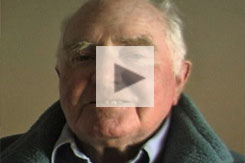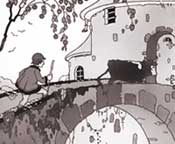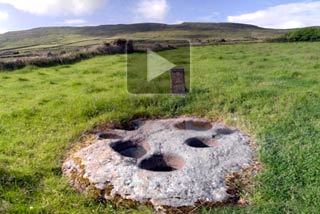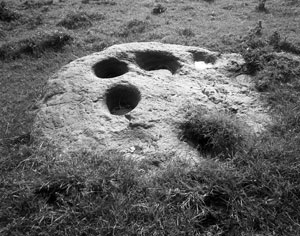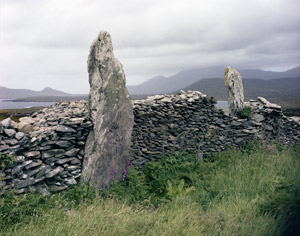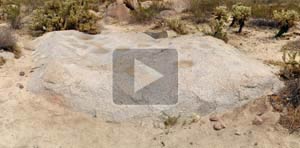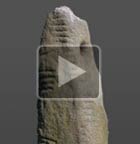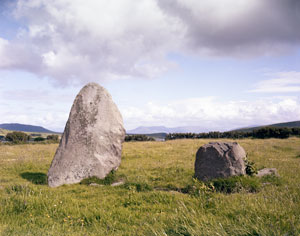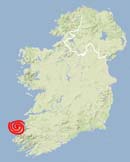13 Oct The Gate of the Cow;
Kilmalkedar Keelers Stone
“Glas Gaibhnenn had milk for all; and when any one came to milk her she would stop, and there never was a vessel that she did not fill. One woman heard this; and once when Glas Gaibhnenn was near a river, the woman brought a sieve and began to milk. She milked a long time. At last the cow saw the river white with milk; then she raised her leg, gave the woman a kick on the forehead, and killed her.
Caol na Crua was doing well, minding the cow all the time, till one evening Glas Gaibhnenn walked between the two pillars where she used to scratch herself; when she was full, her sides would touch both pillars.”
Jeremiah Curtin, Hero-Tales of Ireland, 1894 1
Drag within the image to explore the Gate of the Cow in virtual reality.
The magical cow Glas Gainach appears in legends throughout the country.2 In contemporary Irish the cow’s name is usually given as Glas Gaibhnenn, “the Green Cow of the Smith.” The creature was connected in legend to Goibhniu, the blacksmith of the Tuatha Dé Danann. Here in Ireland’s most western reaches are two stone monuments vividly bringing into the landscape this enchanted cow whose milk was ever flowing. Both of these monuments may be explored here in virtual reality (left). Noted Dingle author and folklorist Doncha Ó Conchúir recounts these legends in the video, below right.
The “Gate of the Cow” (Geata an Ghlas Ghaibhnigh) is formed by a pair of prehistoric standing stones on a hillside above the village of Baile an Fheirtéaraigh (Ballyferriter), not far from the infamous massacre site at Smerwick. These are the “two pillars” noted in the story excerpted above. They are now incorporated into a modern field wall. Between these stones this magical bovine of benevolence would stand, her grand width completely filling the 4.15 m (13.6 ft) space between them.3
About 5 km (3 mi) to the northeast sits the ruined twelfth-century Kilmalkedar Church. In an adjacent field is a large bullaun stone, its seven man-made depressions serving as bowls on the surface of the bedrock outcropping. Called the “Keelers Stone” it was here that the Glas Gaibhnenn was said to position herself, standing above the stone and freely decanting her bounty of milk into the bullauns. See the bullaun in virtual reality, below right, with a hotspot linking to the churchyard. Bullaun stones are discussed in detail below.
“There was no need to milk her, as you only had to place the vessel under her and she milked herself into it. When no one came to her for milk, she milked herself into the basins of the Keelers Stone.” 4
There are some 95 standing stones known throughout the Dingle Peninsula, most believed to date from the Early to the Late Bronze Age (c. 2500-700 BCE). Only a few of them were set up in rows, making a stone alignment as seen in the Gate of the Cow, and also in the nearby Gates of Glory (below, left).5 Many observers have noted that such stone alignments are oriented to celestial events, such as the summer solstice alignment at Cloonsharragh.
The Gate of the Cow and the Gates of Glory are not the only stone alignments that have acquired a reputation in folklore. A prominent example in Co. Meath would be the twin stones on the Hill of Tara, “Blocc and Bluigne,” which are reputed to bar entry between them to any unworthy person.6 Also in Meath, the “Speaking Stones” at Farnaglough were said to have settled disputes. However, as folklorist Kevin Danaher noted, it would be unwise always to assume an Irish standing stone, or gallan, is as old as its hoary mantle of lichen might indicate:
“There are many standing stones to be found, singly or in groups, over the whole of Ireland. Of course not all of them are burial monuments, and not all of them are ancient. Witness the remark of the Kerry farmer to a group of antiquarians.
‘Here is the gallan now for ye. Professor Hackenbush ascribes it to the Bronze Age, but me own theory, supported by that of me Uncle Jerry, that quarried it and put it up, is that it is a scratching post for the cattle.'” 7
Translators assembled the story of the magical cow Glas Gaibhnenn from a number of brief accounts in the original medieval material, which may have been based upon earlier oral traditions. One of those who popularized the story was Lady Gregory, with Gods and Fighting Men (1905). In her chapter “The Coming of Lugh,” three brothers, Goibniu the smith, Samthainn, and Cian are in possession of Glas Gaibhnenn. But when Cian went to Goibniu’s forge to have a new sword made, he left Samthain in charge of the magical cow. Then the evil Balor, with his single transfixing eye, distracted Samthain and stole away with the cow to his own island across the water.
“When Cian saw his brother coming in he rushed out, and there he saw Balor and the Glas out in the sea. And he had nothing do to then but to reproach his brother, and to wander about as if his wits had left him, not knowing what way to get his cow back from Balor. At last he went to a Druid to ask an advice from him; and it is what the Druid told him, that so long as Balor lived, the cow would never be brought back, for no one would go within reach of his Evil Eye.” 8
The story continues with Cian’s efforts to recover Glas Gaibhnenn. However this quest soon becomes but a subplot in a long odyssey in which Cian impregnates Balor’s daughter and the god Lugh is born to them.9 Lady Gregory told the story in her “Kiltartanese” style, an attempt to write English with an Irish syntax.10 The earlier version by Jeremiah Curtin (top) was written in a more colloquial style, as a fairy tale. Doncha Ó Conchúir, in the interview (above right) extracts from the Glas Gaibhnenn stories only those elements that are bound to the local landscape.
We visited with Doncha Ó Conchúir during our initial fieldwork in western Dingle in the summers of 1979-80. His voice is also featured on our entry about the off-the-beaten-track ancient site near Dún Chaoin (Dunquin) called Tigh Mhóire. Our last visit to the folklorist, when we recorded the video interview on this page, was in 2001, just three years before his death. He was proud of these local monuments that allow such a tangible connection to the traditional legends. He was especially eager for us to visit the roughly 2.5 m- (8.2 ft-) square Keelers Stone, where the connection in folklore to the Glas Gaibhnenn’s milk is reflected in the belief of some archaeologists that these bullauns may have been used for separating milk and cream. Very close to the Keelers Stone another bullaun, with but one large bowl, was found during road construction in 1984. It is now set in an upright position next to a wall on the west side of the roadway.11
“The depressions were explained as saints’ pillows (in the case of single depressions) or the marks of a saint’s knees while praying (double depressions). But it would have needed a lot of saints to explain the bullauns with up to nine depressions.” 13
Bullaun stones are to be found throughout Ireland, usually in close proximity to ecclesiastical sites, such as at Ballyvourney in Co. Cork. Peter Harbison suggests that they may have had some function related to pilgrimages, perhaps used for dispensing holy water. The Kilmakedar bullauns are located near the route of the Saint’s Road pilgrimage leading up to the ascent of Mount Brandon.12 Many of these stones even today are believed to hold water with medicinal powers; some are even called “wart wells” for the curative powers of the rain or dew found in the basin. Perhaps this belief is a consequence of the bullauns’ dimly remembered association with religious pilgrimage?
Other bullauns, with small round stones placed in their bowls, were used as “cursing stones.” The small stones would be rotated counter-clockwise while the intended target of the curse was named. This was considered a procedure fraught with danger because, if the curse were deemed unjust, it could rebound on the operator of the stones. Such practices continue today, as we found when we visited the cursing stone bullaun at the ruins of St. Brigid’s Church in Co. Cavan.
T.J. Westropp described a most curious ritual involving a bullaun stone in 1903. A stone at Ardmore, Co. Waterford, with a hole at the bottom of its bullaun, was used in a ceremony on Ash Wednesday. A pole was set into the hole, and covered in a coarse fabric. The young men of the village would then dance around it, afterwards inducing unmarried girls into the frenzy, and then parading them through the streets perched on logs. “Owing to the scandalous meaning attached to these rites, they were put down, and the stone removed and buried.”14
Ireland’s Sites and Monuments Record in 2008 listed 837 bullaun stones in the country. Archaeologists agree that they most likely date from the early medieval period (c. 500-1200); however there is no such agreement as to their purpose. Many observers point out their similarity to stone basins used today in some indigenous cultures for the grinding of foodstuffs. An example of such a stone, from the pre-20th century Kumeyaay culture of southern California, may be seen in a virtual-reality view below. If the Irish bullauns were really analogous to the grinding mortars used by Native American cultures, they might have been used similarly as “gossip stones,” where women (the primary food processors) could converse while working together on their domestic chores.15 This might explain why some Irish bullauns have so many bowls carved in a single large stone: to accommodate the conversation.
Other archaeologists point to different potential uses for the multi-bullaun stone. Citing evidence found at Gallen Priory, near Ferbane in Co. Offaly, where an ironworking area featured a large stone slab with a 50-cm (20-in) basin scooped out of it, Brian Dolan proposed that some bullauns would have served for the crushing and sorting of ore in metallurgy.16
Most Irish bullauns are found in association with early medieval church sites, and the Keelers Stone is no exception. In the next field to the east is Kilmalkedar Church (Cill Maolchéadair) one of the most important ecclesiastical sites on the Dingle Peninsula, its 4-hectare (10-acre) site serving as the assembly area for pilgrims readying themselves for the ascent up Mt. Brandon. According to some authors, there is evidence on the site that the church was built on a site sacred before the coming of Christianity.17 The church may be visited in virtual reality by clicking on the hotspot available in the VR of the Keelers Stone. Dedicated to the seventh-century St. Maolceadair, the present church building dates from the twelfth century. The Romanesque architecture is enhanced in places with human and animal visages staring down at the visitor in stone carvings.18
These animal heads provided at least one nineteenth-century author, one of the antiquarian writers reluctant to credit the ancient Irish as the builders of the country’s national monuments, with a way to describe the Kilmalkedar Church as a pre-Christian “Cuthite” structure:
“The building is called ‘Teampull Melchedor,’ which…may be translated [as] ‘The Temple of the Golden Molach.’ On the inside of the soffit stone of the doorway is sculptured in relief the head of an Ox—the Golden Molach himself. The presence of this emblem of divinity is explained by the learned Bryant, who tells us that ‘it was usual with the Amonians [Cuthites] to describe upon the architrave [lintel] of their temples some emblem of the deity who there presided.’ The Ox’s head on the architrave of the ‘Temple of the Golden Molach’ is eight inches broad, and projects five inches above the surface of the stone…” 19
Another informant named O’Connor (Ó Conchúir) related a story of the Kilmalkedar Church with a more authentic sense to it. In June of 1979 Bosco O’Connor told us that in local lore the church was said to have been constructed overnight:
“The whole church was built in one night by the fairies, or people like that. And they couldn’t finish it because they were supposed to have the building built before sunrise. And they were doing very well ’til this fellow fell off. And that is why the church to this day remains without a roof. And then there is a window in the side of that church, and it’s called ‘chlós snota,’ ‘the eye of a needle.’ And if you lived to go through this window then you are saved. If not, too bad, you’re going to the other place; you are damned.” 20
The churchyard features a very old sundial and an even more ancient standing stone, one with ogham writing and a perforation near its top. This stone is visible in the VR environment of the church (linked from the Keelers Stone, top left), 180° from the church doorway. According to some observers, this may be a Bronze Age standing stone, with its ogham inscription added in the Early Christian era. The stone may also be viewed in a highly detailed close up by clicking on the image, above right. View in full-screen mode, and scroll the image up and down to see all the ogham writing. The inscription has been read as ANM M(AI)LE INBIR BROCANN, which may mean “the name of Mael Inbir, son of Brocan.”21 There’s a second inscription, also visible in our close up view, which may read M(A)QI.
Other holed stones may be noted inside the Kilmalkedar Church. Within Voices from the Dawn, additional holed standing stones worth exploring include one that has a role in Co. Donegal’s Gleann Cholm Cille Turas. The Aghade Holed Stone in Co. Carlow figures in the mythological origins of the Uí Néill tribe, and the Doagh Holestone of Co. Antrim continues to have a role in local marriage customs.
The hole in the Kilmakedar ogham stone seems to be a unique feature among the Irish ogham stones. The stone has its own place in the folklore of the site; visitors to the stone today, continuing an age-old tradition, will put a finger into the hole for good luck. In the past those suffering from “rheumatism, falling sickness [epilepsy], or other ills might, by passing three times around it, with faith and prayers, be restored to health.”22
Until recently these folk beliefs, and many others relating to the ancient monuments here at the western end of the Dingle Peninsula, might still be heard in the neighborhood. Now, if someone is willing to relate any of the old stories, it is likely his source was a book rather than a seanchaí regaling his neighbors in front of a crackling fire. However as Doncha Ó Conchúir indicated in the video recorded in 2001 (above right), there may not be any further interest in these tales for a modern audience.
“Whether any of the next generations continue on the traditions is doubtful. The things that delighted the former generations would have no effect on the present day generation. And I’m sure much less on future generations.” 23
Click here to see all the notes from this page.
The Gate of the Cow; the Kilmalkedar Keelers Stone, Co. Kerry
Nearest Town: Dingle
Townlands: Ballineanig and Kilmalkedar
Latitude: 52° 10′ 25.65″ N
Longitude: 8° 20′ 1.86″ W

